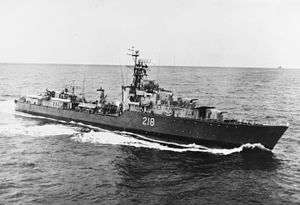HMCS Cayuga (R04)
 HMCS Cayuga in 1954 | |
| History | |
|---|---|
| Name: | Cayuga |
| Namesake: | Cayuga nation |
| Ordered: | April 1942 |
| Builder: | Halifax Shipyards, Halifax |
| Laid down: | 7 October 1943 |
| Launched: | 28 July 1945 |
| Commissioned: | 20 October 1947 |
| Decommissioned: | 27 February 1964 |
| Motto: |
|
| Honours and awards: | Korea 1950-52[1] |
| Fate: | Scrapped, Faslane |
| Notes: | Colours: Gold and scarlet |
| Badge: | Blazon Or, an Indian of the Cayuga tribe, facing dexter, in kneeling posture, right knee on the ground, left leg bent and forward, two feathers in hair, lower part of body clad, upper bare, a quiver of arrows pendant from the left shoulder, the base resting on ground beside the right knee, the Indian holding a bow and arrow in the "ready "position all gules.[1] |
| General characteristics | |
| Class and type: | Tribal-class destroyer |
| Displacement: |
|
| Length: | 377 ft (114.9 m) |
| Beam: | 37.5 ft (11.4 m) |
| Draught: | 9 ft (2.7 m) |
| Propulsion: | 3 × Admiralty 3-drum boilers, steam turbines, 2 shafts, 44,000 shp |
| Speed: | 36 knots (67 km/h) |
| Range: |
|
| Complement: | 190 (219 as leader) |
| Armament: |
|
HMCS Cayuga was a Tribal-class destroyer that served in the Royal Canadian Navy from 1946 until 1964. She saw action in the Korean War. She was named for the Cayuga nation, a First Nations people of Canada.
Cayuga was ordered in April 1942 as part of the 1942 building programme.[2] She was laid down on 7 October 1943 by Halifax Shipyards at Halifax, Nova Scotia and launched 28 July 1945.[3] Cayuga was commissioned on 20 October 1947 at Halifax with the pennant number R04.[2][3]
Service history
On 4 February 1948, Cayuga transferred to the west coast for Esquimalt, British Columbia.[3] In October 1948, Cayuga joined the cruiser Ontario, destroyers Athabaskan, Crescent and the frigate Antigonish in sailing to Pearl Harbor, Hawaii; the largest deployment of the Royal Canadian Navy following the war.[4] In March 1950, with Ontario and Sioux, the destroyer participated in a training cruise to Mexico, making several port visits.[5]
Korean War
Cayuga served a total of three tours of Korea, the last in 1954 after the conflict had ended. Cayuga was part of this initial first dispatch of three ships by Canada to Korea, departing Esquimalt on 5 July 1950.[3] In 1952, Cayuga was reconstructed as a destroyer escort[3] and given the new hull number 218. It was on this vessel that Ferdinand Demara, "the great impostor", served while impersonating a Canadian medical officer.
After the Korean War, Cayuga served as a training ship on the west coast. On 1 January 1955, Cayuga was assigned to the Second Canadian Escort Squadron. The initial commanding officer of the group was Commander Henry H. Davidson, captain of Cayuga.[6] In November 1955, the Second Canadian Escort Squadron was among the Canadian units that took part in one of the largest naval exercises since the Second World War off the coast of California.[7] In January 1959 she transferred back to Halifax. There the destroyer escort served as a training ship until being paid off on 27 February 1964. The destroyer was sold for scrap and broken up at Faslane, Scotland in 1965.[3]
RCSCC Cayuga
In 1954 the 30th Royal Canadian Sea Cadet Corps, RCSCC Exeter was renamed after HMCS Cayuga and renumbered 140, and continues to operate to this day, on CFB Wainwright, Alberta. The Coxswain of 140 RCSCC Cayuga, is Cadet Chief Petty Officer Second Class (CPO2) K. Jeckells. The Commanding Officer is C. I. C. Sub-lieutenant L. Jeckells, and the Executive Officer is C. I. C. Air Force Captain, J. Wojcick. There are about 15 cadets in regular attendance on weekly parade nights.
See also
Notes
- 1 2 3 Arbuckle, p. 22
- 1 2 "HMCS Cayuga (R04)". uboat.net. Retrieved 17 June 2014.
- 1 2 3 4 5 6 Macpherson and Barrie, p. 240
- ↑ "Plenty of Seatime". The Crowsnest. Vol. 1 no. 1. King's Printer. November 1948. p. 2.
- ↑ "Pacific Training Cruise". The Crowsnest. Vol. 2 no. 5. King's Printer. March 1950. p. 2.
- ↑ "Two New Squadrons for Pacific Command". The Crowsnest. Vol. 7 no. 4. Queen's Printer. February 1955. pp. 2–3.
- ↑ "Biggest West Coast Exercises Held". The Crowsnest. Vol. 8 no. 2. Ottawa: Queen's Printer. December 1955. pp. 2–3.
References
- Arbuckle, J. Graeme (1987). Badges of the Canadian Navy. Halifax, Nova Scotia: Nimbus Publishing. ISBN 0-920852-49-1.
- Brice, Martin H. (1971). The Tribals. London: Ian Allan. ISBN 0-7110-0245-2.
- Robert Crichton, The Great Imposter, Random House, New York, 1959
- English, John (2001). Afridi to Nizam: British Fleet Destroyers 1937–43. Gravesend, Kent: World Ship Society. ISBN 0-905617-95-0.
- Macpherson, Ken; Barrie, Ron (2002). The Ships of Canada's Naval Forces 1910—2002 (Third ed.). St. Catharines, Ontario: Vanwell Publishing. ISBN 1-55125-072-1.
External links
| Wikimedia Commons has media related to HMCS Cayuga (218) (ship, 1947). |